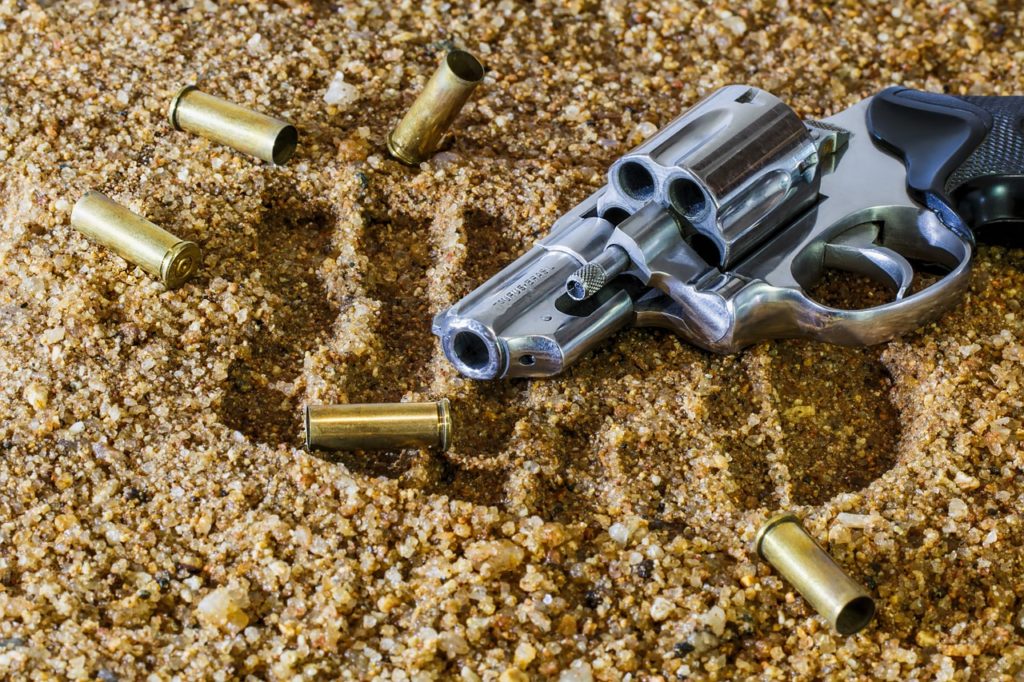Die Frage, ob Waffen mehr Sicherheit bieten, ist so alt wie die Waffen selbst. Viele Menschen glauben, dass der Besitz einer Waffe sie vor Gefahren schützt. Aber ist das wirklich so? In diesem Beitrag nehmen wir diese weit verbreitete Annahme unter die Lupe.
Mehr Waffen = mehr Sicherheit?
Die Frage, ob mehr Waffen mehr Sicherheit bringen, ist ein umstrittenes Thema – die Statistik und Studien sprechen hier allerdings eine klare Sprache!
- Eine Studie des American Journal of Public Health aus dem Jahr 2013 fand heraus, dass es in Staaten der USA, in denen mehr Waffen pro Kopf im Umlauf waren, signifikant mehr Todesfälle durch Schusswaffen gab. Auch andere Studien zeigen ähnliche Ergebnisse.
- In einem Bericht von 2016 hat die Zeitschrift Epidemiologic Reviews 130 Studien aus 10 Ländern analysiert und dabei festgestellt, dass in Gebieten mit einer höheren Rate an Waffenbesitz auch eine höhere Rate an Todesfällen durch Schusswaffen vorliegt.
- Zum Beispiel hat Australien nach einem Massaker in Port Arthur 1996 ein strenges Waffenrecht eingeführt und seitdem keine Massenschießereien mehr erlebt. Der Rückgang der Schusswaffentoten ist nach dem Waffenverbot signifikant.
Auf der anderen Seite gibt es das Argument, dass Waffen zur Selbstverteidigung dienen und daher die Sicherheit erhöhen können. Zum Beispiel argumentieren einige, dass Gebiete mit strengen Waffengesetzen, wie zum Beispiel Chicago, immer noch eine hohe Rate an Schusswaffengewalt haben, was darauf hindeuten könnte, dass Waffengesetze nicht der einzige Faktor sind.
Viele der Fälle, in denen Schusswaffen zur Selbstverteidigung verwendet werden, sind oft komplizierter als sie auf den ersten Blick erscheinen. Eine Studie von 2015 in der Zeitschrift Injury Prevention zeigte, dass in den meisten Fällen, in denen Menschen glaubten, eine Schusswaffe zur Selbstverteidigung verwendet zu haben, die Waffe tatsächlich eher die Gewalt eskaliert hat als sie zu stoppen.
Es ist ein komplexes Thema mit vielen Nuancen und kann nicht eindeutig mit „Ja“ oder „Nein“ beantwortet werden.

Verletzung des Angreifers
In erster Linie müsst Ihr natürlich bedenken, dass der Einsatz von Waffen schnell eine schwere Verletzung des Anderen herbeiführen kann. Bei der Verwendung einer Schreckschusswaffe beispielsweise tritt ein hoher Druck am Ausgang des Laufs auf, der, wenn er auf das Gesicht gerichtet austritt, schwere Verletzungen nach sich ziehen kann. Auch mit einem Messerstich fügt Ihr schnell irreparable oder tödliche Verletzungen zu.
- Solltet Ihr gezwungen sein, eine Waffe einzusetzen, dann zielt nach Möglichkeit auf die Gliedmaßen, nicht auf Kopf oder Torso. Denn es gibt jedoch Urteile wegen Körperverletzungen mit nachfolgender Behinderung, die dafür sorgen, dass der Angeklagte fünfstellige Summen als Strafe zahlen muss.
- Eine schwere Verletzung des Angreifers kann nicht nur Eurem Gewissen einen tiefen Stich versetzen, sondern Euch auch vor Gericht für schuldig erklären und hohe Strafzahlungen nach sich ziehen. Das kommt aber darauf an, hier kann leider keine absolute Antwort gegeben werden. Denn es kommt darauf an, ob die Verteidigung als Notwehr ausgelegt wird.
- Ganz wichtig an dieser Stelle: Wenn Ihr in Gefahr seid und um Euer Leben bangen müsst, dann ist so gut wie alles erlaubt – bitte lest dazu unseren Beitrag zur Notwehr.
Aber das sollte eure kleinste Sorge sein, denn die Waffe soll Euch einen Moment Zeit verschaffen, in der Ihr flüchten könnt, nicht mehr und nicht weniger. Und um es auf den Punkt zu bringen: Es ist die letzte Möglichkeit, die Euch vor Gewalt, Raub, Vergewaltigung oder eine anderen schlimmen Tat schützen kann.
Verteidigung mit Waffen Notwehr?
Hier betreten wir ein rechtlich sehr gefährliches Terrain. Sicher ist das Notwehrrecht im Allgemeinen nicht einfach, aber die Verwendung von Waffen zum Selbstschutz ist noch deutlich komplizierter. Im Handel gibt es diverse Gegenstände zur Selbstverteidigung, deren Erwerb in manchen Fällen sogar ohne jeden Aufwand möglich ist. Weiterhin gilt Verteidigung als Notwehr, wenn sie erforderlich ist, um einen rechtswidrigen Angriff abzuwenden. Hier unterscheidet das Notwehrrecht nicht zwischen unbewaffneter und bewaffneter Notwehrhandlung.
Die tatsächliche Eignung von Waffen zum Selbstschutz werdet Ihr kaum anzweifeln, die rechtliche Eignung hingegen ist schwierig. Anbei ein paar Beispiele.
- Notwehr beim Hells Angel Prozess 2011 – Beitrag auf faz.net
- Notwehr mit einem Bierkrug nach einem Angriff – Beitrag auf rechtsindex.de
- Notwehr unter Einsatz einer lebensgefährlichen Waffe – Beitrag auf hrr-strafrecht.de
Ein weiteres großes Problem entsteht auch immer dort, wo es Zeugen gibt, denn Kamerahandys sind allgegenwärtig. Wenn Ihr zum Beispiel geschlagen werdet und anschließend zurückschlagt, ein Zeuge aber nur Euren Schlag mit dem Handy gefilmt hat, steht Ihr schnell auf der anderen Seite der Anklagebank. In diesem Fall hilft Euch auch das Notwehrrecht nicht mehr.
Ihr seht also: Recht haben und Recht bekommen sind zwei verschiedene Dinge, also schöpft erst alle anderen Möglichkeiten aus, bevor Ihr Gewalt anwendet.
Angreifer entwaffnet Euch
Ihr Euch Gedanken darüber, was passiert, wenn der Angreifer Eure Waffe in die Hand bekommt – aber zurecht?
- Letztendlich sollte die Waffe nur eingesetzt werden, wenn wirklich nichts anderes mehr hilft: Hilfe rufen oder Flucht.
- Möglicherweise reicht ja bereits das Vorzeigen der Waffe aus, um den Angreifer zu vertreiben,
- Sollte der Angreifer Eure Nahkampfwaffen wie Schlagstöcken oder Elektroschockern, in die Hände bekommen, kann es sein, dass er oder sie verärgert ist und sie gegen Euch einsetzt.
- Bedenkt auch, dass beim Einsatz von einigen Nahkampfwaffen ausreichend Kenntnis vorhanden sein muss, damit Ihr diese auch effektiv einsetzen könnt.
Jedoch ist es richtig, die Gefahr ist nicht von der Hand zu weisen: Wenn der Angreifer Eure Gegenwehr abwehren kann, wird er möglicherweise verärgert sein und sie gegen Euch einsetzen. Wenn es aber keine Möglichkeit mehr gibt eine Tat abzuwenden, dann solltet Ihr es versuchen! Bei kleineren Streitereien sollte es tunlichst vermieden werden, Waffen einzusetzen. Dadurch eskaliert die Situation, ohne dass es nötig gewesen wäre.
Waffen brauchen Munition!
Eine weitere Gefahr, wenn Ihr Euch auf eine Waffe verlasst, ist der Moment der Ablenkung, in welchem Ihr nach dieser greift. Ihr werdet kurzzeitig verwundbar, wenn Ihr in der Handtasche wühlt oder Euch zum Handschuhfach runterbeugt. Es ist nicht in jeder Situation gefahrlos möglich, die Waffe zu ziehen und zu entsichern. Möglicherweise müsst Ihr Euch dadurch doch mit blanken Händen verteidigen.
Nicht alle Waffen bleiben dauerhaft einsatzbereit und können in einem Ernstfall versagen, wenn sie keine regelmäßige Wartung bekommen. Bei einem Elektroschocker etwa können sich die Batterien entladen, wenn dieser jahrelang in der Tasche mitgeführt und nie kontrolliert wird. Bei einer Schreckschusswaffe könnte sich die Mechanik mit Schmutz zusetzen und dann im Ernstfall verklemmen. In diesen Fällen baut Ihr Euch selbstsicher mit der Waffe vor Eurem Angreifer, damit schließlich nichts passiert. Dann kommt zu der ohnehin schon gefährlichen Situation Euer Schreck hinzu und wird Euch noch zusätzlich verunsichern. Wenn Ihr Euch eine derartige Selbstverteidigungswaffe zulegen wollt, müsst Ihr daran denken, diese regelmäßig auf Funktionsfähigkeit zu überprüfen.

Bessere Alternativen als Waffen
Waffen mögen auf den ersten Blick wie eine schnelle Lösung für das Problem der persönlichen Sicherheit erscheinen. Aber sind sie wirklich die beste Option? Es gibt zahlreiche Alternativen, die nicht nur sicherer, sondern auch gesetzeskonformer sind.
Haus einbruchssicher gestalten, Alarmanlage installieren: Euer Zuhause ist eure Festung. Warum also nicht in eine gute Alarmanlage investieren oder die Fenster und Türen einbruchssicher machen? Mit modernen Sicherheitssystemen könnt ihr in Echtzeit Benachrichtigungen auf euer Smartphone erhalten und sogar die Polizei automatisch alarmieren lassen. So habt ihr immer ein Auge auf euer Zuhause, auch wenn ihr nicht da seid.
Selbstverteidigungskurs erlernen: Wissen ist Macht, und das gilt auch für die Selbstverteidigung. Ein Selbstverteidigungskurs kann euch beibringen, wie ihr euch in verschiedenen Gefahrensituationen verhalten solltet. Ihr lernt, potenzielle Bedrohungen zu erkennen und wie ihr euch effektiv verteidigen könnt, ohne eine Waffe zu benötigen.
Kampfsport lernen: Kampfsportarten wie Karate, Judo oder Krav Maga bieten mehr als nur körperliche Fitness. Sie schulen auch eure Reaktionsfähigkeit und euer Bewusstsein für die eigene Sicherheit. Im Ernstfall könnt ihr diese Fähigkeiten nutzen, um euch oder andere zu schützen.
Gefahrensituationen meiden: Der beste Weg, um sicher zu bleiben, ist natürlich, Gefahrensituationen von vornherein zu vermeiden. Seid euch eurer Umgebung bewusst, meidet schlecht beleuchtete oder unsichere Gebiete und hört auf euer Bauchgefühl. Wenn etwas nicht stimmt, ist es oft besser, sich zurückzuziehen und Hilfe zu suchen.
Insgesamt bieten diese Alternativen eine umfassendere und oft sicherere Lösung für das Problem der persönlichen Sicherheit. Sie erfordern zwar eine gewisse Investition an Zeit und Geld, aber im Gegenzug bieten sie ein höheres Maß an Sicherheit und Seelenfrieden.
Fazit
Natürlich bieten Waffen Gefahren und wir würden diese nie uneingeschränkt empfehlen und möchten abschließend noch drei Empfehlungen loswerden:
- Wenn man sich eine Selbstverteidigungswaffe zulegt, sollte man im nächsten Schritt damit trainieren und sich mit der Waffe vertraut machen.
- Waffen dürfen nie einfach so eingesetzt werden, sie sind für absolute Notsituationen und den Tatbestand der Notwehr vorbehalten.
- Die Abwehr muss sitzen. Wenn Ihr euch verteidigt, dann macht es richtig, sodass der Angreifer kampfunfähig ist und Ihr Zeit für die Flucht habt.
Unsere Haltung
Bitte versteht uns nicht falsch, wir möchten hier keine Partei für die Täter ergreifen. Es muss nur jedem bewusst sein, dass Waffen schnell zu einer Eskalation führen können. Und das kann die Auswirkungen auf das Opfer noch weiter verschlimmern.
Wir empfehlen daher jedem Grundtechniken einer Kampfsportart zu erlernen und darüber hinaus kann noch eine Selbstverteidigungswaffe erworben werden (bspw. Pfefferspray). So ist man auch ohne Waffe wehrhaft und hat noch einen Joker in der Hand für den Notfall.
- Boxsack Basics: Findet den perfekten Boxsack für euer Heimtraining - 23. November 2023
- Mobbing am Arbeitsplatz: Tipps & Hilfestellungen für Betroffene - 15. November 2023
- Wohnung & Haus effektiv vor Einbruch schützen: 10 Tipps & FAQ - 3. November 2023

